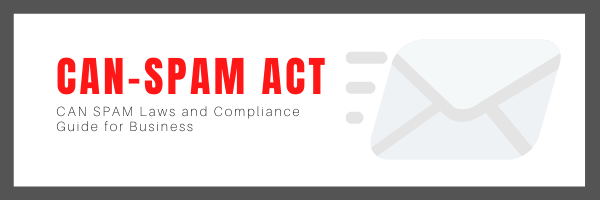On December 16, 2003, the President George W. Bush signed into law the CAN-SPAM Act. The Act, which took effect on January 1, 2004.
CAN-SPAM, a direct response of the increasing number of complaints over spam e-mails, defines a “commercial electronic mail message” as “any electronic mail message the primary purpose of which is the commercial advertisement or promotion of a commercial product or service (including content on an Internet website operated for a commercial purpose).” It exempts “transactional or relationship messages.”
Rules to Follow for CAN-SPAM Compliance
For every single email that violates the CAN-SPAM Act is subject to penalties of up to $43,280.
So if you’re caught being non-compliant for a list of, say, 5,000 … well, you do the math.
So non-compliance can be costly. But following the law isn’t difficult.
Here’s a summary of CAN-SPAM’s main requirements:
#1: Don’t use false or misleading header information
This means that your email must clearly and accurately identify the person or business (the business that is sending the email) in the “From,” “To,” “Reply-To,” and “routing information” including the originating domain name.
#2: Don’t use deceptive subject lines
Do not be dishonest, misleading or inaccurate with your subject lines to get people to open your email. Your subject line should accurately reflect the content of the message.
#3: Admit that it’s an ad
It not compulsory to use the word “ad” in the subject line. But, as per the CAN-SPAM Act, it is required to disclose clearly and conspicuously that it is an ad.
This can be as simple as putting text at the bottom of the email stating, “This advertisement was sent by (your business name here).”
#4: Tell recipients where you’re located
As per CAN-SPAM Act, you must include your current, valid physical postal address in every email. This can be your current street address, a post office box you’ve registered with the U.S. Postal Service, or a private mailbox you’ve registered with a commercial mail receiving agency established under Postal Service regulations. This is typically placed at the bottom of each email.
#5: Tell recipients how to opt out / unsubscribe of receiving future email from you
The CAN-SPAM Act requires that every email sent must include a clear and conspicuous explanation of how the recipient can opt out / unsubscribe from that email list.
#6: Honor opt-out requests promptly
You should remove opted-out email address from your list within 10 business days. Once the consumer’s email is removed from the list, you are not permitted to use it, transfer it or sell it from that moment forward.
#7: Monitor what others are doing on your behalf.
The law makes clear that even if you are using a third party to handle your email marketing, you can’t contract away your legal responsibility to comply with the CAN-SPAM Act.
Both the company whose product is advertised in the email and the company that actually sends the email may be held legally responsible.
Now that you know what the CAN-SPAM rules are, you may be wondering how relevant they still are, given their over 15-year reign.
On February 12, 2019, the Federal Trade Commission announced the completion of the first regulatory review of the Controlling the Assault of Non-Solicited Pornography and Marketing Act (“CAN-SPAM”) Rule (the “CAN-SPAM Rule” or “Rule”). By a vote of 5-0, the FTC voted to retain the CAN-SPAM rule with no modifications.
In other words – CAN-SPAM isn’t going anywhere. So if your business is subject to the guidelines of the spam act, the time to comply is now.

